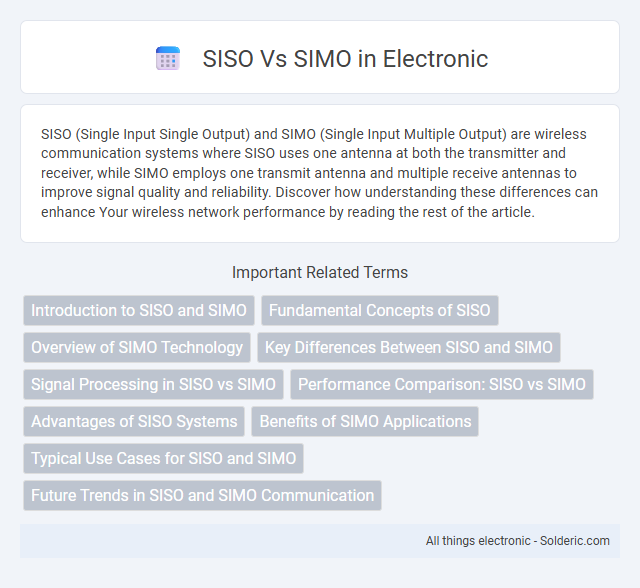SISO (Single Input Single Output) and SIMO (Single Input Multiple Output) are wireless communication systems where SISO uses one antenna at both the transmitter and receiver, while SIMO employs one transmit antenna and multiple receive antennas to improve signal quality and reliability. Discover how understanding these differences can enhance Your wireless network performance by reading the rest of the article.
Comparison Table
| Aspect | SISO (Single Input Single Output) | SIMO (Single Input Multiple Output) |
|---|---|---|
| Definition | One input, one output system | One input, multiple outputs system |
| Input Signal | Single antenna or source | Single antenna or source |
| Output Signal | One antenna or receiver | Multiple antennas or receivers |
| Complexity | Simple design and implementation | Higher complexity due to multiple outputs |
| Data Throughput | Limited by single channel capacity | Improved reliability and diversity gain |
| Application | Basic communication systems | Diversity reception, wireless communication systems |
| Performance | Susceptible to fading and interference | Enhanced signal quality via combining techniques |
Introduction to SISO and SIMO
SISO (Single Input Single Output) systems transmit and receive data through one antenna, offering simplicity and ease of implementation in wireless communication. SIMO (Single Input Multiple Output) systems enhance signal reliability and quality by using one transmit antenna and multiple receive antennas to exploit spatial diversity. Understanding the differences between SISO and SIMO is essential for optimizing Your wireless network performance depending on the application needs.
Fundamental Concepts of SISO
SISO (Single Input Single Output) systems process one input signal to produce one output signal, forming the basis of traditional communication models. The fundamental concept of SISO revolves around understanding the channel's response to a single transmission path, enabling straightforward analysis of signal behavior and noise effects. Your grasp of SISO principles is crucial for comparing it to more complex models like SIMO, which use multiple outputs from a single input to improve signal reliability.
Overview of SIMO Technology
SIMO technology, or Single Input Multiple Output, enhances wireless communication by using one transmitting antenna and multiple receiving antennas to improve signal quality and reliability. This configuration allows for spatial diversity, reducing the effects of fading and increasing reception performance in environments with interference. Your wireless systems can achieve better data throughput and connection stability by implementing SIMO technology.
Key Differences Between SISO and SIMO
SISO (Single Input Single Output) systems use one antenna for both transmitting and receiving signals, providing simpler design and lower cost. SIMO (Single Input Multiple Output) systems employ one transmit antenna and multiple receive antennas, enhancing signal reception and reliability through diversity gain. You can choose SIMO over SISO when improved signal quality and reduced fading effects are critical in wireless communications.
Signal Processing in SISO vs SIMO
Signal processing in SISO (Single Input Single Output) systems involves managing a single transmission path, which simplifies filter design and channel estimation but limits spatial diversity and capacity. In SIMO (Single Input Multiple Output) systems, signal processing exploits multiple receive antennas to enhance performance through diversity gain and improved signal quality, utilizing techniques like maximal ratio combining (MRC). The use of multiple receive antennas in SIMO enables more robust detection and interference mitigation compared to the single antenna scenario in SISO.
Performance Comparison: SISO vs SIMO
SIMO (Single Input Multiple Output) systems outperform SISO (Single Input Single Output) in terms of signal reliability and data throughput by leveraging multiple antennas at the receiver to reduce fading and interference. This spatial diversity in SIMO enhances error rates and overall performance without increasing transmission power, making it suitable for challenging wireless environments. Your communication system benefits from SIMO's improved robustness and higher spectral efficiency compared to the simpler SISO configuration.
Advantages of SISO Systems
SISO systems offer simplicity in design and implementation, resulting in lower cost and reduced hardware requirements compared to SIMO configurations. They provide efficient channel utilization and reliable performance in environments with limited multipath interference. The reduced signal processing complexity in SISO enables faster and more power-efficient communication, making it ideal for straightforward wireless applications.
Benefits of SIMO Applications
SIMO (Single Input Multiple Output) technology enhances wireless communication by improving signal reliability and coverage through multiple receiving antennas, reducing fading and interference. Your devices experience stronger connectivity and higher data rates compared to SISO (Single Input Single Output) systems, making SIMO ideal for mobile networks and indoor environments. This improvement supports more stable wireless connections critical for streaming, gaming, and real-time applications.
Typical Use Cases for SISO and SIMO
SISO (Single Input Single Output) is commonly used in systems like traditional wired communication and simple control systems where one input controls one output, ensuring straightforward design and low complexity. SIMO (Single Input Multiple Output) finds typical use in wireless communications such as MIMO antenna arrays and audio broadcasting where one source triggers multiple outputs to enhance coverage and reliability. Applications of SIMO include Wi-Fi routers and smart speakers, leveraging multiple output channels to improve signal reach and user experience.
Future Trends in SISO and SIMO Communication
Advancements in SISO (Single Input Single Output) and SIMO (Single Input Multiple Output) communication systems are steering towards enhanced spectral efficiency and energy conservation, vital for next-generation wireless networks like 6G. Machine learning algorithms are increasingly integrated to optimize channel estimation and signal processing in both SISO and SIMO frameworks, improving reliability under dynamic conditions. The evolution of massive SIMO configurations promises substantial gains in throughput and coverage, supporting the growing demands of IoT and ultra-reliable low-latency communications.
SISO vs SIMO Infographic

 solderic.com
solderic.com